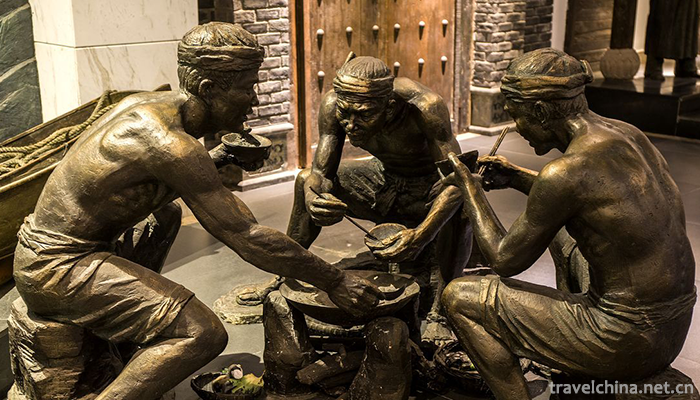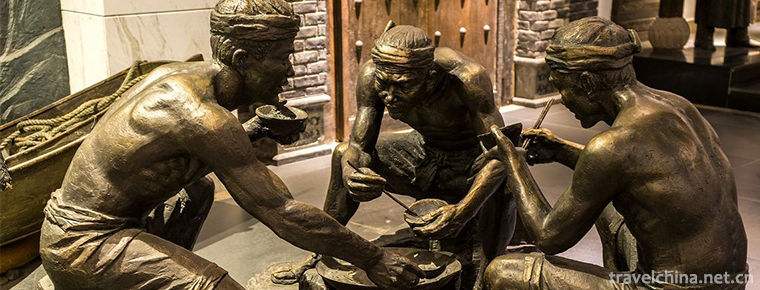Copper Carving Skills
Copper Carving Skills
Copper sculpture, a traditional handicraft in Hangzhou, Zhejiang Province, is one of the national intangible cultural heritage.
Hangzhou bronze sculpture is the continuation of ancient bronze manufacture. It developed greatly in Wuyue and Southern Song Dynasty. After Tongzhi in Qing Dynasty, Hangzhou bronze sculpture represented by "Zhufu Bronze Art" became more and more mature and handed down from generation to generation.
In June 2008, bronze sculpture was listed in the second batch of national intangible cultural heritage list of traditional skills, project number_-119.
historical origin
Initial Origin
The origin of Hangzhou bronze carvings can be traced back to the ancient Bronze Age. Since the Xia Dynasty, the Chinese have created a bronze civilization. In the cultural history of Zhejiang Province, the bronze swords of Yue King in the Spring and Autumn Period and the bronze mirrors of Huiji in the Western Han Dynasty were the representatives of bronze culture. At the beginning of the 12th century, the Song Dynasty moved southward to Linan (now Hangzhou). Hangzhou became the political, economic and cultural center of the whole country at that time. A large number of bronze artisans flocked into the area, taking Datong alley near Drum Tower as the center, and manufacturing a large number of armor Weapons such as knives, bows, crossbows and other daily copper instruments.
Heyday
During Tongzhi period of Qing Dynasty, bronze ware became a necessity of people's daily life. Bronze products have undergone significant changes in style and technology. In 1876, Zhufu Bronze Shop appeared. Since then, there has been a professional workshop for the production of bronze products, which inherited the bronze technology. The products are traditional in composition, layout, shape and decoration, as well as technical treatment. They are interlinked with bronze technology and merged with blood.
The bronze pots, hooks, pots and pots of the Qing Dynasty are representative works of bronze sculpture. Their carving techniques cooperate with each other. They are exquisite and delicate. They delight people with lifelike shapes, especially in carving teapots and various jewelry. They are exquisite and cost-effective. Customers often queue up to buy, and business is booming. At that time, the mosaic was the joint between copper and copper, mainly floating mosaic, which was expensive and only used by the officials and officials. In the late Qing Dynasty, inlay materials such as gold, silver, jade, stone and wood were abundant. Generally local materials, low cost, beautiful appearance, popular, so widely used in bronze carving, Hangzhou people call it "bronze inlay". This process only places the jade, stone and wood on the copper plate, and then glues them several times to make them firm. The combination of copper and stone, copper and jade, as an art form, has novel artistic effects and becomes home furnishings and collections.
Decline Period
On December 24, 1937, Japanese invaders invaded Hangzhou and occupied it for eight years. During this period, the national economy suffered great damage and people's livelihood was depressed. Western foreign goods flooded the domestic market, domestic crafts suffered heavy losses, some small workshops closed down, a large number of craftsmen fled to other places to make a living, Hangzhou Datong Lane also did not have the previous prosperous scene.
Japan, South Asia and Western European countries have rushed to China to buy folk treasures. As the times require, intermediaries have emerged. They do not tell the truth or falsehood, do not tell the good or bad, and they need to see the goods, causing chaos in the market. Due to the depression of the industry, the skilled bronze craftsmen are forced to make a living and have no choice but to change their professions. The former Zhufu bronze art has lost its original glory and become a general commodity. The precious traditional skills are endangered.
Renaissance Period
After the founding of New China, Hangzhou copper carving withered wood in spring. The third generation inheritors of Zhufu Copper Art moved to Hangzhou, settled down in Datong Lane of Hefang Street, set up a copper shop and resumed the production of copper carvings. In addition, the West Lake Garden, Zhu Deyuan Painting and Calligraphy Society, was established in Hangzhou to combine ancestral skills with Hangzhou bronze art, specializing in bronze characters, bronze medals and bronze works of art. Through the reform of sculpture technology, the creative techniques and forms of expression of copper carving have been enriched, and the art of copper carving has slowly recovered its vitality.
Inheritance and Protection
Inheritance value
Hangzhou bronze sculpture products cover architecture, sculpture, calligraphy, murals, interior decoration and other aspects, the content is very extensive. According to the variety, Hangzhou bronze carvings mainly include bronze pagodas, bronze halls, bronze bridges, bronze boats, bronze doors, bronze statues and so on. In production, Hangzhou bronze carving applies traditional techniques such as hollowing, overlapping, baking, green making, melting mould and dotting to achieve perfect artistic effect. The bronze Hall of Leifeng Pagoda and Lingyin Temple in Hangzhou, Tianning Temple Pagoda in Changzhou, Jiangsu, Daxiong Palace in Emeishan, Sichuan, Grand Master Temple of Jintan in Taichung City, Taiwan Province, and the large-scale bronze relief "Map of Buddha's Fall" and "Map of Xuanzang's Pursuit of Dharma" are all representative works of Hangzhou bronze sculpture with high artistic value.
Current situation of inheritance
Because of the difficulty and long learning time, young people are reluctant to learn traditional bronze carving skills. With the change of social life, copper pots and other daily necessities are gradually eliminated, the practice of copper carving production is stagnated, and the lack of scientific research on this traditional handicraft and other protective measures, Hangzhou copper carving technology has been in an endangered state.
Heritage figures
Zhu Bingren, male, Han nationality, was born in Shaoxing City, Zhejiang Province in November 1944. In June 2009, Zhu Bingren was selected as the representative successor of the third batch of national intangible cultural heritage projects and declared in Hangzhou, Zhejiang Province.
protective measures
In 1985, the fourth generation of inheritors Zhu Bingren and Zhu Bingxin jointly set up the Venus Copper Material Factory to inherit the skills of Zhufu Copper Art, cultivate a group of skilled young technical backbone, and investigate the origin, formation, prosperity, decline and revival of Hangzhou Copper Sculpture. It took three years to compile the materials of Hangzhou Copper Sculpture.
social influence
Important activities
On November 3, 2012, the 2nd China (Tongling) International Copper Sculpture Art Exhibition of "Copper Rhyme Dream" was held in Tongling City.
On July 24, 2012, the unveiling ceremony of the creation base of the 2nd China (Tongling) International Copper Carving Art Exhibition was held at the New Jiuding Copper Culture Industry Base in Tongling.


-
1.Baishuiyang Yuanyangxi Tourist Area
Baishuiyang Mandarin Creek is located in Pingnan County, Ningde City, Fujian Province. It is 170 kilometers away from Fuzhou and 101 kilometers away from Ningde
Time 2018-12-08 -
2.Langyatai Scenic Area
Langyatai Scenic Spot belongs to Qingdao Langyatai Provincial Tourism Resort (established in December 1995 with the approval of Shandong Provincial People's Government with a planned area of 9.8 squar
Time 2019-01-29 -
3.Mogao Grottoes
Mogao Grottoes, commonly known as Thousand Buddha Caves, are located in Dunhuang at the western end of Hexi Corridor. It was built in the pre-Qin period of the Sixteen Kingdoms.
Time 2019-02-07 -
4.Answer drum
Answer drums are popular in Quanzhou City, Fujian Province, other areas in southern Fujian Province and Taiwan Province, Hong Kong and Macao, as well as among overseas Chinese
Time 2019-04-22 -
5.Forty eight Zhai Song Festival
The forty-eighth Village Song Festival is a northern Dong dialect Song Festival in Tianzhu County, Guizhou Province, China. It is a traditional national festival featuring Dong
Time 2019-05-01 -
6.Imakan of Hezhe Nationality
Imakan is a unique rap art of the Hezhe people in Northeast China. Its performance form is a combination of one person's rap and singing. It has no accompaniment with musical instruments and uses the
Time 2019-05-03 -
7.Hengshui painting
Hengshui Inner Painting, a traditional folk art in Hengshui, Hebei Province, is one of the national intangible cultural heritage.
Time 2019-05-03 -
8.Liyuan Opera
Liyuan Opera is one of the traditional operas in Fujian Province. Liyuan Opera originated in Quanzhou in the Song and Yuan Dynasties. It is also called "the voice of Fujian and Zhejiang" and
Time 2019-05-12 -
9.Traditional Brewing Techniques of Brewing Wine
Chrysanthemum wine is a necessary drink for Chongyang Festival. It has a long history of brewing. Royal chrysanthemum liquor of Ming and Qing Dynasties was a kind of precious liquor created on the bas
Time 2019-06-09 -
10.a type of Shaanxi Opera popular in the Weinan Dali region
Bowl-bowl tune is one of the local operas in Shaanxi Province, also known as "lamp-bowl tune" and "Ruan'er tune". The former is named for the main rhythm of the small copper bowl a
Time 2019-06-25 -
11.Yongchun Paper Weaving Painting
"Yongchun County Chronicle" records: "In the early Tang Dynasty, Yongchun had the production of paper-woven paintings. Yongchun paper weaving painting features: interwoven paper marks,
Time 2019-07-14 -
12.Ding Zhen from the plateau Village
The 20-year-old Tibetan boy is from a small mountain village in Litang County, Ganzi Tibetan Autonomous Prefecture, Sichuan Province. More than 20 days ago, a photographer released a short video on the short video platform, which made Ding Zhen
Time 2020-12-07